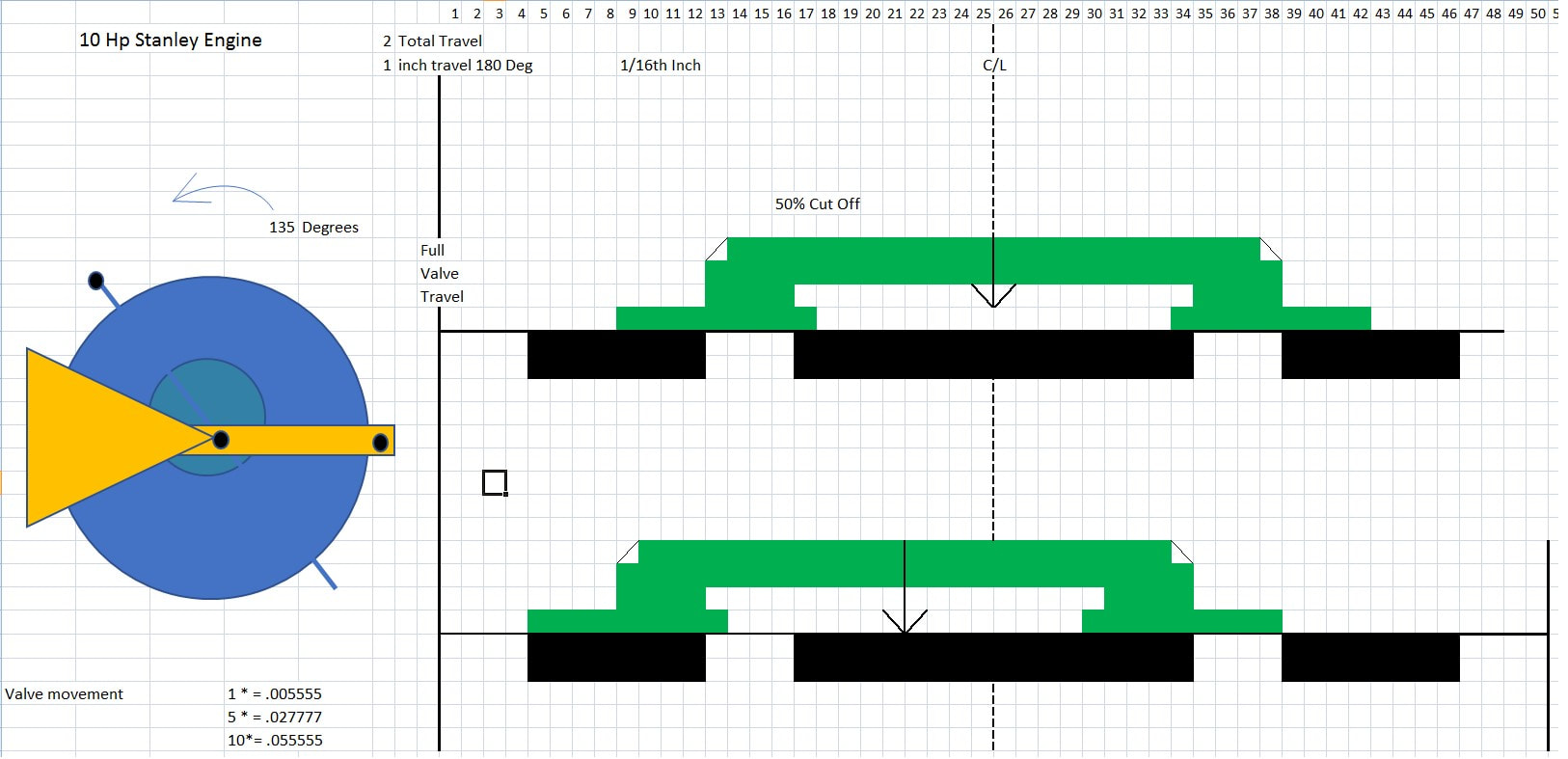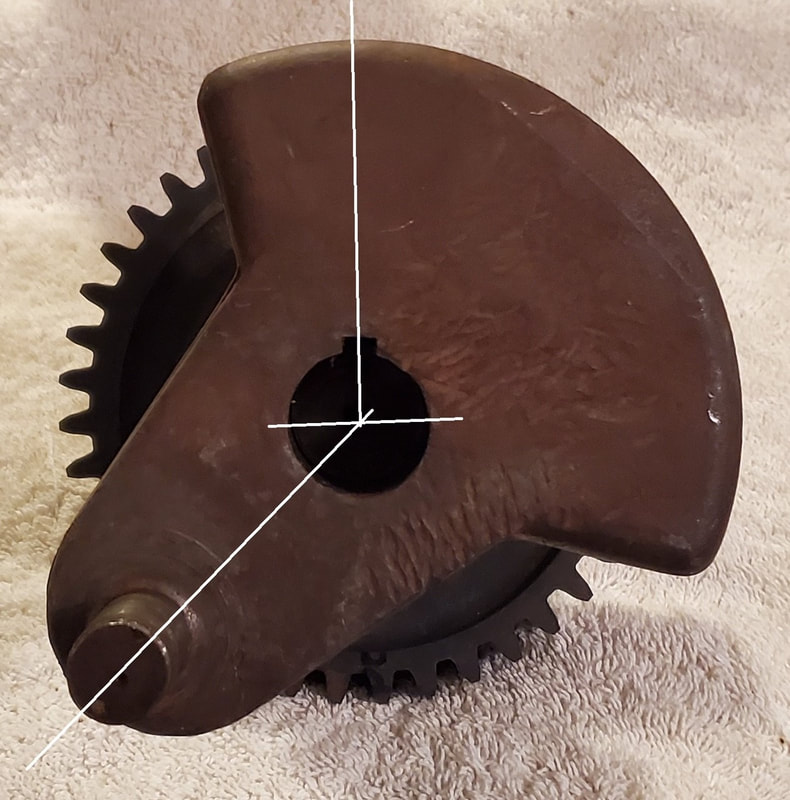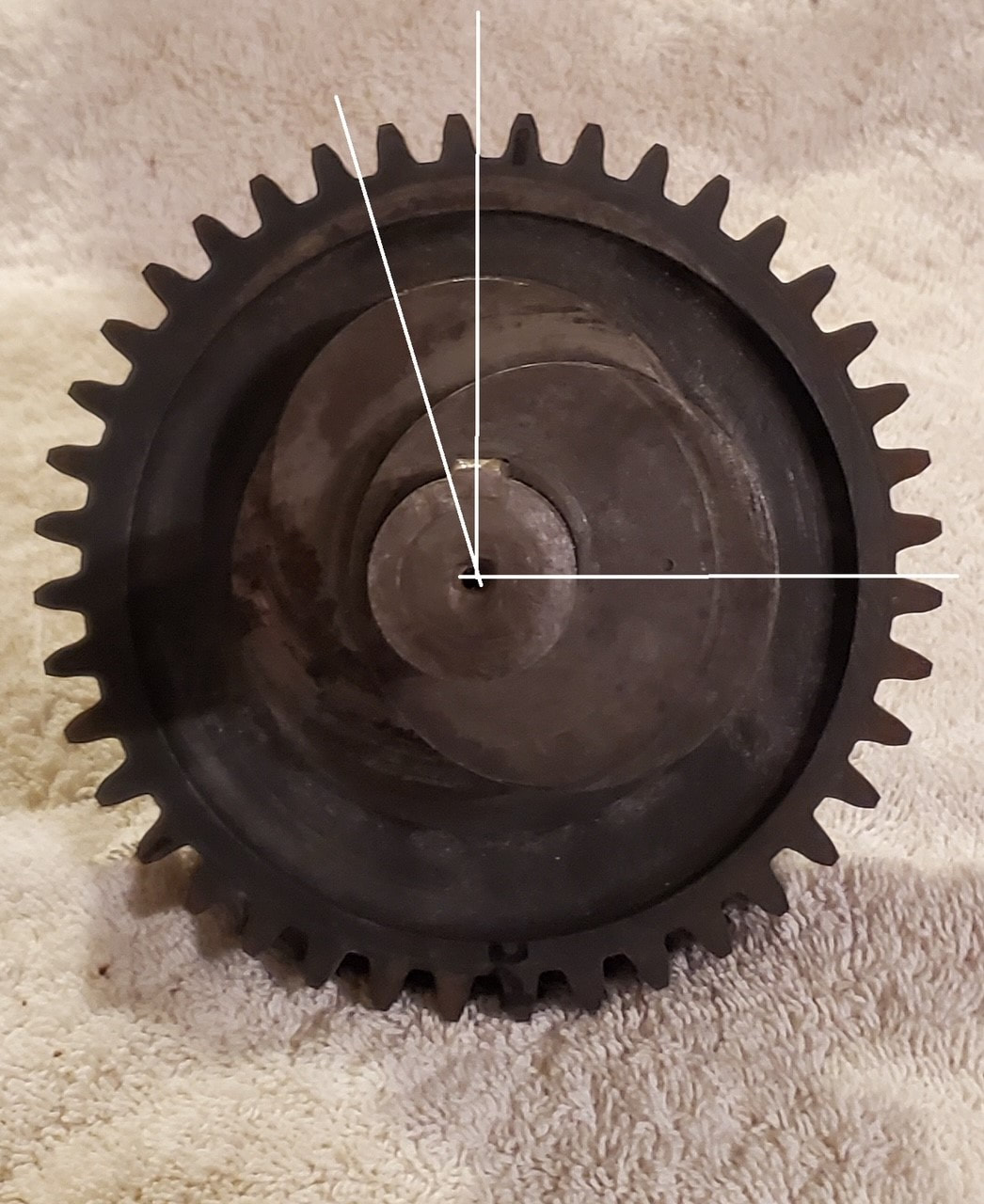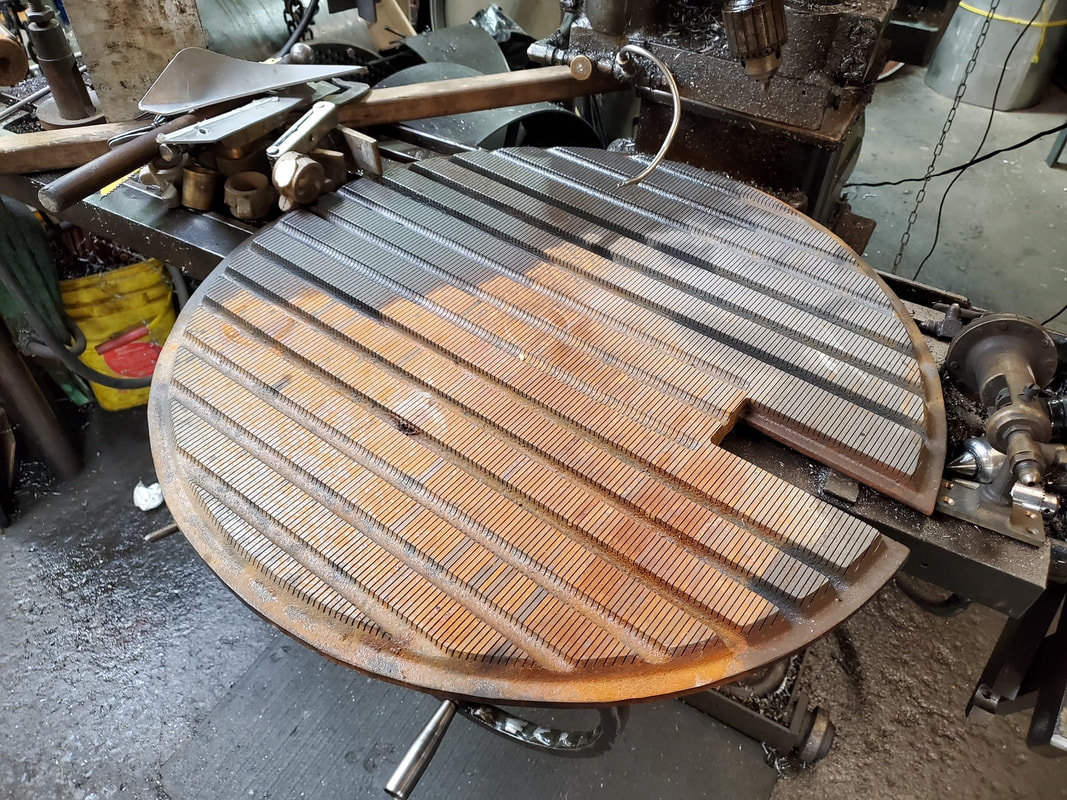|
Billy Barnes Land Speed Record by Rick Heinig credit to the Steam Automobile Club of America PART THREE BELOW 10 HP Valve Simulation Initial - The first view of the D-slide valve establishes the valve and its steam and exhaust lap. It is centered over the port openings. The second view is to establish the 135 Degree angle from the eccentric picture exercise. This establishes the lead on the engine. BELOW 10 HP Valve Simulation - This shows the valve movement starting with the piston at top-dead -center. The establishment of the eccentric angle (lead) and lap shows the 50% cut off. I believe that the design intent is to establish the lead angle first and then determine lap to get the proper cut-off. BELOW Crank Throw Angle - using a picture and paintbrush, this identifies the crank throw angle relative to the key way. BELOW
Eccentric Angle - picture shows the eccentric angle relative to the key way. The relationship between the key way establishes the 135 Degree angle between the crank and eccentric. This happens to be a key feature to establish the 50% cut off in the 10 HP Stanley Steam Engine.
0 Comments
Billy Barnes Land Speed Record by Rick Heinig credit to the Steam Automobile Club of America PART FOUR About the Barnes Burner, it is reported that it does not howl and will not blow back. The construction is made out of stainless steel with welded seams to not allow any puddling of gasoline that will auto ignite when not wanted. Billy does rebuild and build Stanley fire tube boilers, new for customers. One of his latest boilers was for Herb de la Porte and his Locomobile. Please give to Cystic Fibrosis and Multiple Sclerosis (within the picture already)
burner on the Model 85 stanley11/27/2022 JOE SHUKAY Front of the burner on the Model 85, showing branch forks, end of vaporizer pipe, clean out cable, pilot, igniter and branch fork nut and compression washers. An Electronic Boiler Water Level Gauge. By David David K. Nergaard
Part One Every operator of a steam car with a boiler having a distinct water level needs to know what that level is at all times. This is important in a Stanley boiler but is critical with many other boilers such as the Baker and Derr. Many cars were fitted with thermostatic water level sensors, of which the Stanley three tube indicator was, perhaps, the most common. These were often reliable in use, but gave no indication what ever when the boiler was cold. Hence, some independent means of verifying the water level before lighting the fire is needed. It is also desirable to have a sensor with a remote indicator. Thus, the sensor can be mounted to give a correct indication of water level regardless of the slope of the hill being climbed while the indicator is still easily seen from the driver's seat. Some years ago, I considered various types of electronic level sensors, many of which I had used as tide or wave height sensors in my years as an electronics engineer in oceanography. Most of these required rather sophisticated electronics mounted directly at the top of the sensor. To work as a boiler water lever sensor, they would have needed more than a order of magnitude increase in sensitivity and the ability to work at the temperature of the steam in the boiler, nearly 500 degrees in the case of a Stanley. I came to the conclusion that something different was needed. Eventually I conceived a type of water level sensor which should be equally accurate whether cold or under steam and which could use a remotely sited electronics circuit. The sensor is a coaxial capacitor in which the central conductor is an insulated rod of comparatively small diameter. The outer, and grounded, conductor is the outer housing of the gauge when empty and the surface of the water touching the insulated rod surface when full. The formula for the capacity per unit length of a coaxial capacitor is a constant times the dielectric constant of the insulating material divided by the logarithm to the base ten of the ratio of the outer radius to the inner radius of the conductors. For measurements in inches, the constant is 0.614 picofarads per inch. I assumed the dielectric constants of air and steam differ only slightly from that of a vacuum. If so, the capacity of the empty gauge should be about that of a bare centre rod in the pipe chosen as the gauge housing. For a one quarter inch diameter rod in a piece of nominal one inch pipe, this calculates to about one picofarad per inch. For the wet part of the sensor, the inner radius is that of the rod, the outer radius is that of the rod plus the thickness of the insulating layer and the dielectric constant is that of the insulation used. Assuming a thickness of 0.01 inch and a dielectric constant of 3 yields about 40 picofarads per inch. This is large enough to be easily measured. The measuring circuit can be connected to the gauge with a length of coaxial cable, which merely adds some capacity to that of the empty gauge. I put together a ten inch long test unit using heat shrink tubing on a bit of one quarter inch copper tube for the centre rod mounted in a piece of one inch iron pipe. The measured capacities of this device were; cable, 73 pF., empty gauge, 20 pF., and full gauge, 317 pF. It was not what I had calculated, but quite good enough to make a workable gauge. There is a common and inexpensive integrated circuit used as a timer. It charges a capacitor through a resistor connected to its supply voltage and generates a pulse whose length is R x C seconds long each time it is triggered. The CMOS version of this device is the TMC555, costs about a Dollar and uses very little power. Even more significant, this version can run faster than the less efficient bipolar transistor versions. In particular, it works beautifully with a resistance of 100,000 Ohms and the sensor described above. The 555 timers can be wired to trigger them selves; thus making an oscillator whose frequency is inversely proportional to the resistance and capacitance used. I breadboarded a circuit using three TMC555s, a low power operational amplifier and an efficient low power voltage regulator. The first timer generated a pulse of length determined by the capacity of the sensor. The second was adjusted to make a pulse equal in length to that made by the first one when the sensor was empty. The third ran as an oscillator and triggered the others simultaneously. All three were powered by the voltage regulator. If one averages the voltage of a series of pulses, one gets gets the voltage of the pulse times the period of the pulse divided by the period between pulses. An operational amplifier (op amp, for short) can be connected to subtract one voltage from another while doing the averaging. Thus, it can subtract the output of the second timer from that of the first and drive a meter with a current that is zero when the gauge is empty and full scale when the gauge is full. Adjusting the period of the second timer sets the zero and adjusting the third timer, which sets the number of pulses per second, adjusts the full scale reading. As the timers use regulated power, the voltage of the battery powering the circuit does not affect the accuracy. For an indicator, I used a Weston type 301 10 milliampere meter of about the same age as my car. Thus, it doesn't look too out of place on the dash and is already conveniently calibrated to read 0 to 10 inches! The meter draws more current than all the rest of the circuit. This is not an issue in a condensing Stanley as the circuit can be run by the existing electric system in the car. How did it work? Beautifully the first time, the meter rising smoothly as I filled the gauge. However, as I emptied the gauge, the meter dropped only slightly and very slowly. A thin film of water on the rod is just as good an outer conductor as a half inch thickness is. And water easily clings to ordinary heat shrink tubing. Experiment result number one: the insulation on the centre rod must not be wetted by the fluid being measured! The immediate logical answer to the problem was Teflon. And, it is available as heat shrink tubing. However, it is not cheap and is normally sold in batches of 100 pieces. After some conversations with the electronic supply house I use, the manufacturer of the tubing very kindly sent sample lengths, a yard each of three different sizes, free of charge. The rod was recovered with a piece of this and the resulting system was demonstrated at the December 2004 meeting of the North-east chapter of SACA. On that occasion, it worked very well, running on a 6 Volt battery. By the way, the dielectric constant of Teflon is about 2.7. There were still questions about whether it would work under steam. The following spring, it was tried on my Stanley, being mounted at the left side of the boiler just forward of the throttle. And the answer was yes, but... My contact to the centre rod was through a modified sparkplug at the bottom of the gauge. It soon developed electrical leakage which essentially shorted the gauge. It was not a dead short, but enough to render the gauge useless. I moved the connector to the top end where any similar problem would not be wet, and that cured that one. However, apparently a thin film of water can form on the sparkplug insulator when it cools down so the gauge often reads pinned full with a cold boiler. It does not do this if the boiler is empty, only if it is left with water in it over night. Sometimes, rapping the gauge at the top shakes off enough of the water to make it read correctly, but not always. I think a new connector fitting using a Teflon insulator will cure this issue. A second problem was more subtle. For the first few hours the car was steamed, the gauge gradually read higher although the water level shown by the original bronze bottle gauge did not change. The readings did stabilize, but after the car was steamed about a half dozen times, it failed completely; shorted out. A post mortem examination gave a possible explanation. When the Teflon tube was shrunk onto the centre rod, a small air gap was trapped inside the tube. The resulting increase in "insulation" thickness explains the lower than expected "full" capacity. Under steam, the air in the gap was gradually replaced with water condensed from the steam, which effectively reduced the insulation thickness, making the gauge read almost 30 percent higher. Okay, recalibrate and go on. Then came the kicker; when the boiler was blown down, that water tried to flash into steam, stretching and, finally, splitting the Teflon tubing. Back to the drawing board, again. My next attempt was to get a new piece of tubing, stainless steel this time, Teflon coated by a commercial firm specializing in such work. They did it free as a manufacturing sample. Fitted to the gauge and tested cold, it looked very good; very good leakage resistance and much higher capacity per flooded inch. But, as soon as there was steam on the boiler, the leakage resistance worsened sharply. The gauge was useless long before there was any measurable steam pressure. Pulled out after only a few hours steaming, that part of the rod which was under water has a curious crazed and bubbly appearance. The part exposed to steam does not have this appearance. Repeat last sentence of previous paragraph. Small Parts, Inc. now sells Teflon heat shrink tubing in single lengths, which makes it reasonable to continue experiments. I made a new centre rod using thin wall brass tube with small holes drilled through it every half inch. The theory was they would allow trapped air to escape during shrinking of the Teflon, reducing the resulting air gap. Also, any possible "flash" steam behind the Teflon tubing could easily escape. So far as it goes, that worked. That sensor was in the car all last season and worked quite well. It is remarkable how quickly the gauge responds. Swiftly going through a few ess curves will make the indicated level swing through a range of about six inches! Mounted where it is, it shows the correct level on any hill and is not affected by acceleration or braking. It still has the cold insulator problem noted above. Towards the end of the season, it developed a problem. If the water level got more than two inches higher than normal, or about eight on the meter scale, the gauge would abruptly read full, pinned. When the water level dropped again, it behaved normally. I suspected a flaw in the Teflon about two inches from the top end, and that is what I found when I pulled it apart at the end of this year's driving. Above the break, the Teflon looks perfect. Below the water level, there was some black dirt, probably iron oxide, but it had no effect on the gauge's operation. At the normal water line, it is a little dirty but showed no other sign of wear. At this time, I have only a guess as to why it failed. Teflon heat shrink requires a rather high temperature to make it shrink and the only way I could do it was over a gas stove burner. I may have gotten that part of the "rod" too hot. At this point, the gauge has worked well enough that others should be able to build working units. Maybe they can improve on my attempts. I will rebuild it this winter, with a new all Teflon connector insulator. The electronic circuit I have used draws only a few milliamperes, plus the current through the meter, 6 milliamperes at "normal" water level. Thus, an ordinary 9 Volt transistor radio battery, NEDA-1604, should run the gauge for about 50 hours. If a one milliampere meter movement is used, even longer battery life will result. This means that the gauge can be fitted easily to any steam car, with a small internal battery if needed. It can be made to any convenient length. Thus, it can still be on scale when the low water automatic has shut off the fire. Most important, it gives valid readings when any of the water level devices ever fitted by Stanley are "off scale", and can do so even when the boiler is cold. The circuit I used is hand wired on a prototyping board less than 3 inches by 4 inches. It fits in a 2 X 3 X 5 inch aluminium box with plenty of room for a suitable battery. I am investigating the cost of having a printed circuit board made. I strongly suggest using a Teflon insulated coaxial cable, such as RG179B/U, as the sensor cable, considering the temperatures to which it will be exposed. Unfortunately, it is usually sold in lengths of 100 feet or longer. I used a bit from my junk box. It has held up well for the four seasons it has been used. |
Archives
December 2022
Categories
All
|
|
|
Steam Car Network functions as a resource for all steam car and steam bike enthusiasts. The website is constantly updated with articles, events, and informative posts to keep the community alive and growing. Feel free to contact us if you have any questions or concerns at the email address below and we will promptly reply.
[email protected] |








 RSS Feed
RSS Feed
